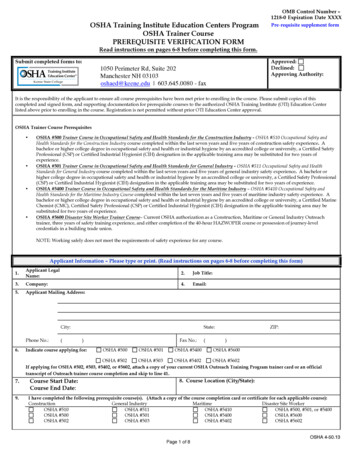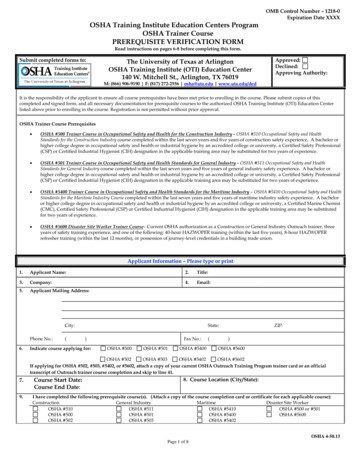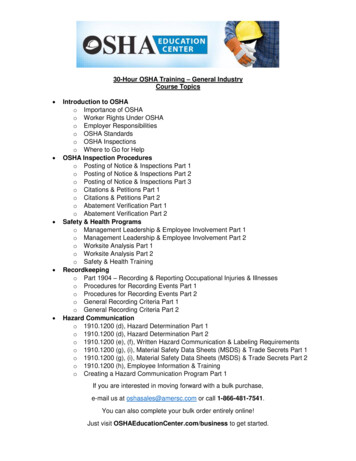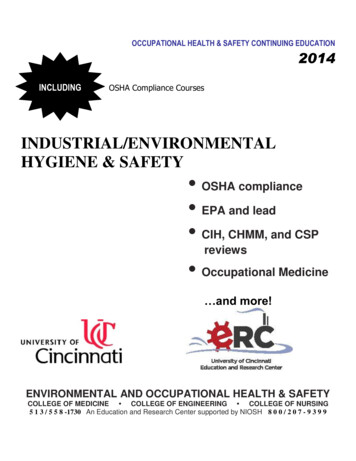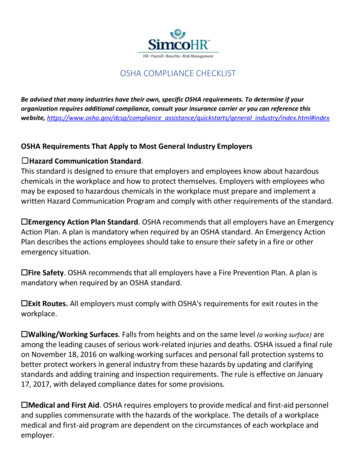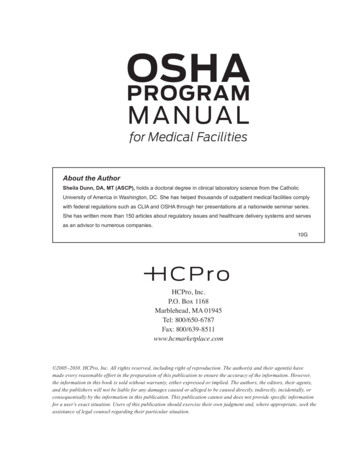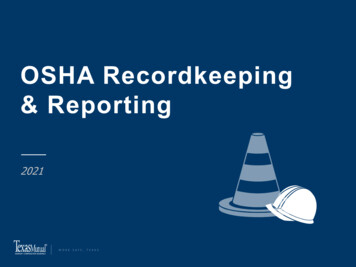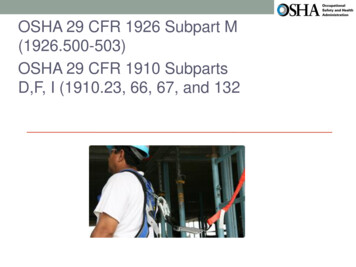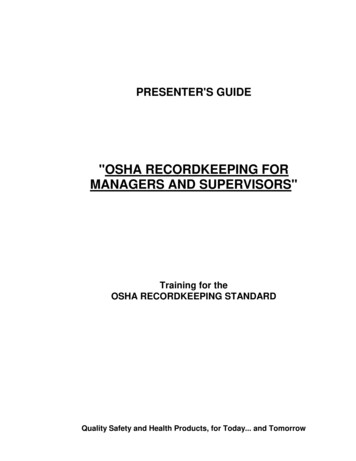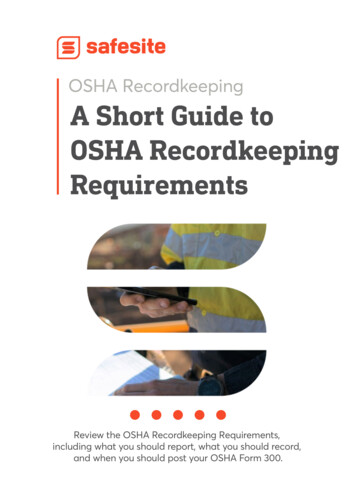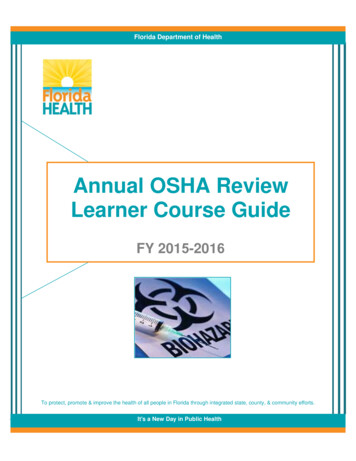
Transcription
Florida Department of HealthAnnual OSHA ReviewLearner Course GuideFY 2015-2016To protect, promote & improve the health of all people in Florida through integrated state, county, & community efforts.It's a New Day in Public Health
FY 2014-2015Annual OSHA Review - Learner Course GuideIt's a New Day in Public HealthThis page left blank intentionallyAnnual OSHA Review - Learner Course GuidePowered by DOH Office of Performance and Quality Improvement
Annual OSHA Review - Learner Course GuideFY 2014-2015It's a New Day in Public HealthTable of ContentsSection Slide Number - Title1PageSlide 1 - Title Slide Section 11Slide 2 - How to Use Navigation1Slide 3 - What Is OSHA?2Slide 4 - Course Goals2Slide 5 - Course Objectives3Slide 6 - Rights and Responsibilities3Slide 7 - Employer Training4Slide 8 - Exposure Control Plan - Goal4Slide 9 - Exposure Control Plan - Source5Slide 10 - Exposure Control Plan - Documentation5Slide 11 - Exposure Control Plan - Location6Slide 12 - What Is Occupational Exposure?6Slide 13 - Handling Biomedical Waste Safely7Slide 14 - Biomedical Waste7iAnnual OSHA Review - Learner Course GuidePowered by DOH Office of Performance and Quality Improvement
Annual OSHA Review - Learner Course GuideFY 2014-2015It's a New Day in Public HealthTable of ContentsSection Slide Number - Title1PageSlide 15 - Employer BMW Plan8Slide 16 - Biomedical Waste Standards8Slide 17 - Biomedical Waste Plans9Slide 18 - Biomedical Waste Segregation9Slide 19 - BMW: Sharps10Slide 20 - BMW: Non-Sharps10Slide 21 - BMW: Sharps Packaging11Slide 22 - BMW: Non-Sharps Packaging11Slide 23 - Biomedical Waste Labeling12Slide 24 - Biomedical Waste Storage12Slide 25 - Biomedical Waste Transport / Treatment13Slide 26 - Biomedical Waste Annual Inspection13Slide 27 - End of Section 114iiAnnual OSHA Review - Learner Course GuidePowered by DOH Office of Performance and Quality Improvement
Annual OSHA Review - Learner Course GuideFY 2014-2015It's a New Day in Public HealthTable of ContentsSection Slide Number - Title2PageSlide 1 - Title Slide Section 214Slide 2 - How to Use Navigation15Slide 3 - Exposure Controls15Slide 4 - Exposure Controls II16Slide 5 - Exposure Controls: Engineering Controls16Slide 6 - Exposure Controls: Work Practice Controls17Slide 7 - Work Practice Controls Handwashing17Slide 8 - Work Practice Controls Handwashing II18Slide 9 - Six-Step Handwashing Technique18Slide 10 - Work Practice Controls Immunization19Slide 11 - Work Practice Controls Immunization II19Slide 12 - Exposure Controls: CDC Work Practice Controls20Slide 13 - Exposure Controls: Work Practice Controls20Slide 14 - Exposure Controls: Personal Protective Equipment21iiiAnnual OSHA Review - Learner Course GuidePowered by DOH Office of Performance and Quality Improvement
FY 2014-2015Annual OSHA Review - Learner Course GuideIt's a New Day in Public HealthTable of ContentsSection Slide Number - Title2PageSlide 15 - Exposure Controls: Personal Protective Equipment Gloves21Slide 16 - Exposure Controls: Personal Protective Equipment Masks22Slide 17 - Exposure Controls: Personal Protective Equipment II22Slide 18 - Exposure Controls: Personal Protective Equipment III23Slide 19 - Exposure Controls: Standard Precautions23Slide 20 - Exposure Controls: Housekeeping Policies24Slide 21 - Exposure Controls: Housekeeping Policies II24Slide 22 - Exposure Controls: Housekeeping Policies - Spill Clean25Slide 23 - Exposure Controls: Housekeeping Policies - Sharps Clean25Slide 24 - Exposure Controls: Safer Needle Regulation26Slide 25 - Exposure Controls: Safer Needle Regulation II26Slide 26 - End of Section 227ivAnnual OSHA Review - Learner Course GuidePowered by DOH Office of Performance and Quality Improvement
FY 2014-2015Annual OSHA Review - Learner Course GuideIt's a New Day in Public HealthTable of ContentsSection Slide Number - Title3PageSlide 1 - Title Slide Section 327Slide 2 - How to Use Navigation28Slide 3 - Section Introduction28Slide 4 - Occupational Exposure Management Protocols29Slide 5 - Occupational Exposure Management Protocols II29Slide 6 - Occupational Exposure Management Protocols III30Slide 7 - Occupational Exposure Management Protocols IV30Slide 8 - Occupational Exposure Management Protocols V31Slide 9 - Florida Health and Safety Policies31Slide 10 - Florida Health and Safety Policies II32Slide 11 - Resource Information32Slide 12 - End of Section 3 and End of Course33AppendixResource and Information PageI35vAnnual OSHA Review - Learner Course GuidePowered by DOH Office of Performance and Quality Improvement
FY 2014-2015Annual OSHA Review - Learner Course GuideIt's a New Day in Public HealthThis page left blank intentionallyAnnual OSHA Review - Learner Course GuidePowered by DOH Office of Performance and Quality Improvement
Annual OSHA Review - Learner Course GuideFY 2014-2015It's a New Day in Public HealthSection 1Slide 1 - Title Slide Section 1Welcome to Section 1 of the Annual OSHAReview.Slide 2 – How to Use NavigationIn order to make your viewing experience as easy aspossible during the course of this DOH RequiredTraining Course presentation we are providing thesenavigation instructions:This presentation is formatted for continuous play.If you need to stop the presentation, click on thePAUSE button, on the bottom left of the screen.When you are ready to continue your viewing, clickon the PLAY button on the bottom left of the screen.Please keep these instructions in mind as youproceed with this presentation.To begin viewing this presentation you will need toclick directly on this slide now.Annual OSHA Review - Learner Course GuidePowered by DOH Office of Performance and Quality Improvement
Annual OSHA Review - Learner Course GuideFY 2014-2015It's a New Day in Public HealthSlide 3 – What Is OSHA?OSHA is the acronym for the Occupational Safetyand Health Administration, which establishes andenforces workplace safety and health standards.OSHA also provides information, training, andassistance to employers and workers. OSHA wascreated in 1970 after the passage of theOccupational Safety and Health Act of 1970. It helpsemployers and employees reduce on the job injuries,illnesses, and deaths. OSHA encourages continualimprovement in workplace safety and health.OSHA is part of the United States Department ofLabor. The administrator for OSHA is the AssistantSecretary of Labor for Occupational Safety andHealth. OSHA's administrator answers to theSecretary of Labor, who is a member of the cabinetof the President of the United States.OSHA’s mission is to assure safe and healthfulworking conditions for working men and women bysetting and enforcing standards and by providingtraining, outreach, education and assistance.Slide 4 – Course GoalsThe goals of this course are to raise employeeawareness of worksite hazards that could lead tobloodborne pathogen or other disease exposures,and encourage workplace practices that will prevent,reduce, or avoid exposures.Annual OSHA Review - Learner Course GuidePowered by DOH Office of Performance and Quality Improvement
Annual OSHA Review - Learner Course GuideFY 2014-2015It's a New Day in Public HealthSlide 5 – Course ObjectivesThe course will also present and discuss exposurecontrols, work practice controls and personalprotective equipment (PPE) designed to aid in thesecontrols.It will review and reinforce protocols to follow in theevent of an occupational exposure and presentemployees information to help them understand theefficacy, safety and benefits of vaccines, as well asencourage completion of the Hepatitis B seriesvaccine by at-risk employees.Slide 6 – Rights and ResponsibilitiesEvery employee has the right to a safe workplace.OSHA was created to make sure your rights areprotected. Employers must use hazard controls tolower employee risk and train employees in safetymeasures. Employers must also offer medicaltreatment for occupational exposures or injuries unlessthe employee refuses medical treatment.Employees are responsible for complying with OSHAregulations and must report occupational illnesses andinjuries to their supervisor and the WorkersCompensation provider.Annual OSHA Review - Learner Course GuidePowered by DOH Office of Performance and Quality Improvement
Annual OSHA Review - Learner Course GuideFY 2014-2015It's a New Day in Public HealthSlide 7 – Employer TrainingEmployer workplace safety training in regards to theprevention of potential workplace exposures mustinclude:Information regarding an exposure control plan,hazard recognition in the workplace, what protectivemeasures should be taken or made available, how toreport occupational illnesses and injuries, and whatfollow-up procedures to take with employees after anincident.Let’s review each of these requirements.Slide 8 - Exposure Control Plan - GoalThe goal of the exposure control plan is to protectemployees by providing training and implementingspecific procedures that will ensure maximum safetyagainst exposure to bloodborne pathogens and otherdiseases.The exposure control plan is the employer’s writtenprogram that outlines the protective measures anemployer will take to eliminate or minimize employeeexposure to blood and other potentially infectiousmaterials (OPIM).Annual OSHA Review - Learner Course GuidePowered by DOH Office of Performance and Quality Improvement
Annual OSHA Review - Learner Course GuideFY 2014-2015It's a New Day in Public HealthSlide 9 – Exposure Control Plan - SourceThe exposure control plan is based on the OSHABloodborne Pathogen Standard 29 CFR 1910.1030.The OSHA Bloodborne Pathogen Standard covers allemployees whose job responsibilities put them at riskfor exposure to bloodborne pathogens. It providesrequirements for employers to ensure employeesafety with regard to occupational exposure tobloodborne pathogens.Slide 10 – Exposure Control Plan - DocumentationThe following documents are included in the exposurecontrol plan: Biomedical Waste/Florida Administrative CodeBiomedical Waste PlanOccupational Exposure ProtocolOSHA Bloodborne Pathogen Standard 29CFR 1910.1030Annual OSHA Review - Learner Course GuidePowered by DOH Office of Performance and Quality Improvement
Annual OSHA Review - Learner Course GuideFY 2014-2015It's a New Day in Public HealthSlide 11 – Exposure Control - LocationCopies of the exposure control plan (ECP) will belocated in each county health department (CHD), inspecifically designated areas.Each local CHD should include the locations of theirECP, and related materials, in their employee trainingand annual updates.Areas where the ECP may be located in a CHDinclude: the supervisor’s or manager’s office forclinical areas where there is a risk of exposure toblood and other potentially infectious materials,epidemiology, the medical director’s office, nursingadministration office, and the local administrationoffice.Slide 12 – What Is Occupational Exposure?The occupational exposure protocol is a list ofdirectives showing employees what to do if they areexposed to blood or body fluids on the job, potentiallyexposing them to bloodborne pathogens.Annual OSHA Review - Learner Course GuidePowered by DOH Office of Performance and Quality Improvement
Annual OSHA Review - Learner Course GuideFY 2014-2015It's a New Day in Public HealthSlide 13 – Handling Biomedical Waste SafelyThis section will discuss hazard recognition andhow to handle biomedical waste safely within aworkplace environment.Slide 14 – Biomedical WasteBiomedical waste (BMW) is defined as any solid orliquid waste which may present a threat of infection tohumans.Biomedical waste plans are written specifically for eachclinical area that generates BMW. Plans are updatedwhen regulations, facility policies, or procedureschange.Biomedical waste is regulated by Florida AdministrativeCode Chapter 64E-16.Annual OSHA Review - Learner Course GuidePowered by DOH Office of Performance and Quality Improvement
Annual OSHA Review - Learner Course GuideFY 2014-2015It's a New Day in Public HealthSlide 15 – Employer BMW PlanEmployer biomedical waste plans must includeprocedures for decontaminating BMW spills,contingency plans for emergencies, descriptions ofpersonnel training and documentation of that training.New employees who will be handling BMW as part oftheir work responsibility must be trained prior tocommencement of duties.Slide 16 – Biomedical Waste StandardsFlorida Administrative Code Chapter 64E-16 hasminimum standards for the segregation, packaging,labeling, transport, treatment, and storage ofbiomedical waste (BMW).Annual OSHA Review - Learner Course GuidePowered by DOH Office of Performance and Quality Improvement
Annual OSHA Review - Learner Course GuideFY 2014-2015It's a New Day in Public HealthSlide 17 – Biomedical Waste PlansThe BMW plans should indicate the position title ofthe employee responsible for packaging, labeling,and preparing BMW for transport.It should also indicate what personal protectiveequipment should be used while handling the BMW.Slide 18 – Biomedical Waste SegregationSegregation is done at the point of origin for thebiomedical waste. For example, in the room or areawhere the BMW is generated.Biomedical waste is divided into two categories forsegregation: Sharps and Non-SharpsAnnual OSHA Review - Learner Course GuidePowered by DOH Office of Performance and Quality Improvement
Annual OSHA Review - Learner Course GuideFY 2014-2015It's a New Day in Public HealthSlide 19 – BMW: SharpsSharps are defined as objects capable of puncturing,lacerating, or penetrating the skin.These objects include but are not limited to discardedneedles, scalpels, staples, glass slides, brokencontaminated glass or hard plastic with sharp orjagged edges containing blood, blood products orbody fluids, dental wires, and extracted teeth withroots attached.Slide 20 – BMW: Non-SharpsNon-Sharps are defined as used absorbent materialssuch as bandages, gauze, or sponges saturated withblood, blood products, body fluids, excretions orsecretions contaminated with visible blood or bloodproducts and the same absorbent materials saturatedwith blood or blood products that are dried.Non-Sharps also include non-absorbent disposabledevices that have been contaminated with blood, bodyfluids, secretions or excretions or are visiblycontaminated with blood and/or non-liquid human tissue,human blood, human blood products, and body fluids.Annual OSHA Review - Learner Course GuidePowered by DOH Office of Performance and Quality Improvement
Annual OSHA Review - Learner Course GuideFY 2014-2015It's a New Day in Public HealthSlide 21 – BMW: Sharps PackagingPackaging biomedical waste sharps must adhere tothe following guidelines.Sharps to be discarded must be placed directly into arigid, leak & puncture resistant sharps container,immediately after use. Sharps containers should besealed when contents reach the “fill line” and storedaway from the general public. Sharps containersmust not be overfilled or shaken. Never place sharpsin the red bags designated for non-sharps, regulartrash, or flush down the toilet.Slide 22 – BMW: Non-Sharps PackagingPackaging for biomedical waste non-sharps mustadhere to the following guidelines.Non-sharps to be discarded shall be placed directly intodesignated red bags that are tear & puncture resistant.Red bags are to be sealed when full and stored awayfrom the general public. Never throw any red bag inthe regular trash or flush down the toilet.Annual OSHA Review - Learner Course GuidePowered by DOH Office of Performance and Quality Improvement
Annual OSHA Review - Learner Course GuideFY 2014-2015It's a New Day in Public HealthSlide 23 – Biomedical Waste LabelingProcedures for labeling biomedical waste are definedby both international standards as well as Floridaadministrative code.Sharps containers and non-sharps red bags musthave the international biological hazard symbol aswell as the words “Biomedical Waste” or otherphrases required by, and listed in, FAC 64E-16clearly visible on their surface. The symbol shall bered, orange, or black and the background color shallcontrast with that of the symbol.All sharps containers & non-sharps red bags meantfor removal from a facility must be labeled with thename & address of the facility prior to containerizingand/or removal from the facility.Slide 24 – Biomedical Waste StorageFor Sharps - The storage period starts when thecontainer is full and is not to exceed 30 days.If a non-sharp is placed in a sharps container, even if itis not considered full, the 30 day period beginsimmediately. Do not place sharps in non-sharpdesignated red bags. Sharps must be stored away fromthe general public.For Non-Sharps - Red bags are to be sealed when fulland stored. Their storage period may not exceed 30days. Non-sharps must be stored away from thegeneral public.Annual OSHA Review - Learner Course GuidePowered by DOH Office of Performance and Quality Improvement
Annual OSHA Review - Learner Course GuideFY 2014-2015It's a New Day in Public HealthSlide 25 – Biomedical Waste Transport / TreatmentThe transport and treatment of biomedical wasteshall proceed using the following guidelines.Biomedical waste shall not be compacted orsubjected to mechanical stress that will compromisethe integrity of the package during transfer.Biomedical waste must be properly segregated,packaged, & labeled prior to transport. A contingencyplan is needed if the transporter does not pick up thewaste.It is the responsibility of the management or thedesignated person to contact another transporter inthis case. Transport records are to be kept for 3years. Treatment of all biomedical waste is done atoff-site facilities.Slide 26 – Biomedical Waste Annual InspectionBiomedical waste inspections are conducted annuallyby the state environmental health office.During the inspections, the inspectors will verify andreview a number of things.They will verify the permit or exemption letter of thefacility, verify that red bags and sharps containers arelocated at the points of origin for biomedical waste, andverify that these containers are labeled according tocode. The inspectors will also review the written BMWplan, employee training records, and BMW pickuprecords for the past three years.Annual OSHA Review - Learner Course GuidePowered by DOH Office of Performance and Quality Improvement
Annual OSHA Review - Learner Course GuideFY 2014-2015It's a New Day in Public HealthSlide 26 – End of Section 1This is the end of the Annual OSHA Review Section 1Please return to the course registrationmanagement page and take the Section 1assessment.Section 2Slide 1 – Title Slide Section 2Welcome to Section 2 of the Annual OSHAReview.Annual OSHA Review - Learner Course GuidePowered by DOH Office of Performance and Quality Improvement
Annual OSHA Review - Learner Course GuideFY 2014-2015It's a New Day in Public HealthSlide 2 – How to Use NavigationIn order to make your viewing experience as easy aspossible during the course of this DOH RequiredTraining Course presentation we are providing thesenavigation instructions:This presentation is formatted for continuous play.If you need to stop the presentation, click on thePAUSE button, on the bottom left of the screen.When you are ready to continue your viewing, clickon the PLAY button on the bottom left of the screen.Please keep these instructions in mind as youproceed with this presentation.To begin viewing this presentation you will need toclick directly on this slide now.Slide 3 – Exposure ControlsAs you recall, the Occupational Safety and HealthAdministration (OSHA) was created to make sure yourrights to a safe and healthy workplace are protectedand requires employers to use hazard controls to loweremployee risk and train employees in safety measures.In regard to exposure controls, OSHA requiresemployers to use exposure controls to eliminate orminimize employee exposures to bloodbornepathogens, promote the safety of workers, provideemployee training, and to provide workers with a safeworking environment.Annual OSHA Review - Learner Course GuidePowered by DOH Office of Performance and Quality Improvement
Annual OSHA Review - Learner Course GuideFY 2014-2015It's a New Day in Public HealthSlide 4 – Exposure Controls IIThis section will discuss the types of exposurecontrols that OSHA requires to be applied in theworkplace. Exposure controls include engineeringcontrols, work practice controls, and the use ofpersonal protective equipment (PPE).Exposure controls also include: standard, followingpre-set housekeeping policies, and adherence to thesafer needle regulations detailed in the OSHABloodborne Pathogens Standard (revised 2001) aspart of the Needle Stick Safety & Protection Act(2000).Let’s review each of these examples.Slide 5 – Exposure Controls: Engineering ControlsEngineering controls are structural or mechanicaldevices that isolate or remove bloodborne pathogenhazards from the workplace.Examples of engineering controls include sharpscontainers, red bags, eye wash stations, andhandwashing facilities.Annual OSHA Review - Learner Course GuidePowered by DOH Office of Performance and Quality Improvement
Annual OSHA Review - Learner Course GuideFY 2014-2015It's a New Day in Public HealthSlide 6 – Exposure Controls: Work Practice ControlsWork practice controls reduce the likelihood ofexposure by altering the manner in which a task isperformed. There are many effective examples ofwork practice controls which will be presented.The most effective of which, per the Centers forDisease Control (CDC), is proper handwashingfollowed by reducing disease exposure throughimmunization of employees.Slide 7 – Work Practice Controls HandwashingHandwashing is the most effective method ofpreventing transmission of bloodborne pathogens.Hands should be washed using soap and running waterfollowing the six-step handwashing technique. If handwashing facilities are not available, an appropriateantiseptic hand cleaner in conjunction with clean cloth,paper towels or antiseptic towelettes should beprovided, however hands should be washed with soapand running water as soon as possible.Annual OSHA Review - Learner Course GuidePowered by DOH Office of Performance and Quality Improvement
Annual OSHA Review - Learner Course GuideFY 2014-2015It's a New Day in Public HealthSlide 8 – Work Practice Controls Handwashing IIHands shall be thoroughly washed with soap andrunning water before gloving, after removing gloves &other PPE, after each patient procedure, beforeleaving the work area, before & after eating, afterusing the bathroom, and after contact with blood,other potentially infectious materials (OPIM), or apossibly contaminated surface.Slide 9 – Six-Step Handwashing TechniqueHere is the six-step handwashing technique aspresented by the Nursing Standard:1.2.3.4.5.6.Palm to palmBacks of handsInterdigital spaces (between fingers)FingertipsThumbs and wristsNailsSpecial attention should be paid to fingertips, thumbsand other areas of hands likely to contact acontaminated site. Hands should be rinsed in cleanwater. This procedure should take a minimum of 10 to15 seconds to perform.Annual OSHA Review - Learner Course GuidePowered by DOH Office of Performance and Quality Improvement
Annual OSHA Review - Learner Course GuideFY 2014-2015It's a New Day in Public HealthSlide 10 – Work Practice Controls ImmunizationThe second most effective work practice control isreducing disease exposure through immunization ofemployees in the workplace.Employees have potential for disease exposure atwork through contaminated surfaces, shared workrelated items such as phones or copy machines,patients, coworkers, and un-covered cough orsneeze transmission.Slide 11 – Work Practice Controls Immunization IIMany immunizations that can prevent the spread ofdisease are available to employees at no cost.They include the immunizations for Influenza (which isrecommended every year), Pneumonia, Hepatitis B,MMR, Varicella and Td/Tdap.Annual OSHA Review - Learner Course GuidePowered by DOH Office of Performance and Quality Improvement
Annual OSHA Review - Learner Course GuideFY 2014-2015It's a New Day in Public HealthSlide 12 – Exposure Controls: CDC Work Practice ControlsThe CDC recommends the following work practicecontrols within the workplace: Wash hands frequentlyTry not to touch your face to prevent infectionentering your nose, mouth, and eyes.Keep frequently touched surfaces disinfectedWear a mask if job duties require closecontact with an infected personPostpone elective field visits and follow-upappointmentsEnforce exclusion of sick staff from the workarea and enforce use of respiratory hygieneand cough strategiesUse non-sterile gloves for any contact withpatientsSlide 13 – Exposure Controls: Work Practice ControlsThe following are other common work practice controlsfrequently used in the workplace to help stop thespread of disease: Performing all procedures involving blood orOPIM in such a manner as to minimizesplashing, spraying, spattering, and generationof dropletsUsing eyewash stations if splashes or spills ofblood or OPIM to the eyes occurNo recapping or bending of contaminatedneedlesNo eating or drinking, applying cosmetics or lipbalms, or handling contact lenses in workareas where there is a reasonable likelihood ofoccupational exposure, andNo food or drink kept in refrigerators oranywhere that blood or OPIM are presentAnnual OSHA Review - Learner Course GuidePowered by DOH Office of Performance and Quality Improvement
Annual OSHA Review - Learner Course GuideFY 2014-2015It's a New Day in Public HealthSlide 14 – Exposure Controls: Personal Protective EquipmentPersonal protective equipment (PPE) is defined asspecialized clothing or equipment worn by anemployee for protection against a hazard.PPE is acceptable to be worn if it prevents blood orOPIM from contaminating clothes, undergarments,skin, eyes, mouth, or other mucous membranes ofthe employee. The supervisor for the workplace willknow the location of PPE at the work site.Personal protective equipment most often includesgloves, masks, eye protection, face shields, CPRshields, gowns, aprons, and laboratory coats.Slide 15 – Exposure Controls: Personal Protective Equipment - GlovesA few of the most commonly used items of PPE aregloves and masks, often in conjunction with eyeprotection such as goggles or glasses and face shields.Gloves are to be worn when it can be reasonablyanticipated that there may be hand contact with blood,OPIM, mucous membranes, and non-intact skin; whenperforming phlebotomy procedures; and when handlingor touching contaminated surfaces.Annual OSHA Review - Learner Course GuidePowered by DOH Office of Performance and Quality Improvement
Annual OSHA Review - Learner Course GuideFY 2014-2015It's a New Day in Public HealthSlide 16 – Exposure Controls: Personal Protective Equipment - MasksMasks in conjunction with eye protection devicessuch as goggles or glasses with solid side shieldsand/or chin-length face shields, shall be wornwhenever splashes, spray, spatter, or droplets ofblood or OPIM may be generated and eye, nose, ormouth contamination can be reasonably anticipated.Fit testing ensures appropriate mask protection forhealthcare personnel whose job duties require themto be in close contact with confirmed or suspecteddiseases that are airborne or to perform high riskaerosol generated procedures.Slide 17 – Exposure Controls: Personal Protective Equipment IIIt is important to effectively prevent employee exposurewhen wearing PPE. Personal protective equipmentshould be worn and handled with extreme awareness.If PPE has been penetrated with blood or OPIM, checkyour body for cuts, scrapes, or other non-intact skinwhen removing PPE.To prevent transmission of bloodborne pathogens toothers and to prevent contamination of environmentalsurfaces, PPE must be removed before leaving thework area. Turn PPE wrong side out when removingand discard in the area where it was used.Annual OSHA Review - Learner Course GuidePowered by DOH Office of Performance and Quality Improvement
Annual OSHA Review - Learner Course GuideFY 2014-2015It's a New Day in Public HealthSlide 18 – Exposure Controls: Personal Protective Equipment IIIPersonal protective equipment is to be provided bythe facility at no expense to the employee.PPE is not helpful if used incorrectly, so it isimportant to assess the situation and the risksinvolved before choosing items for employeeprotection. Be sure to choose protective equipmentthat is appropriate for the specific tasks beingundertaken.Slide 19 – Exposure Controls: Standard PrecautionsStandard Precautions is the primary infection controlstrategy set by the Centers for Disease Control andPrevention (CDC). They are applied to all patients, andare designed to minimize the risk of catching aninfection from a patient or spreading infection amongpatients.Standard Precautions integrate and expand UniversalPrecautions to include organisms spread by: Blood,all human body fluids, secretions, and excretionsexcept sweat, regardless of whether they containblood, non-intact skin, and mucous membranes.Universal Precautions was first introduced in 1987 toprevent the spread or the transmission of bloodbornepathogens to the health care providers.Standard Precautions is the outgrowth of UniversalPrecautions. The concept of Standard Precautions wasestablished to expand the course of UniversalPrecautions and in 1996 the CDC replaced UniversalPrecautions with Standard Precautions.Annual OSHA Review - Learner Course GuidePowered by DOH Office of Performance and Quality Improvement
Annual OSHA Review - Learner Course GuideFY 2014-2015It's a New Day in Public HealthSlide 20 – Exposure Controls: Housekeeping PoliciesHousekeeping policies involve methods for cleaningwork surfaces and equipment, to help protectemployees from the spread of disease transmitted viapotentially contaminated items or areas. Appropriatepersonal
Annual OSHA Review . Learner Course Guide . FY 201. 5-201. 6. It's a New Day in Public Health Annual OSHA Review - Learner Course Guide FY 2014-2015. This page left blank intentionally . Annual OSHA Review - Learner Course Guide Powered by DOH Office of Performance and Quality Improvement.
